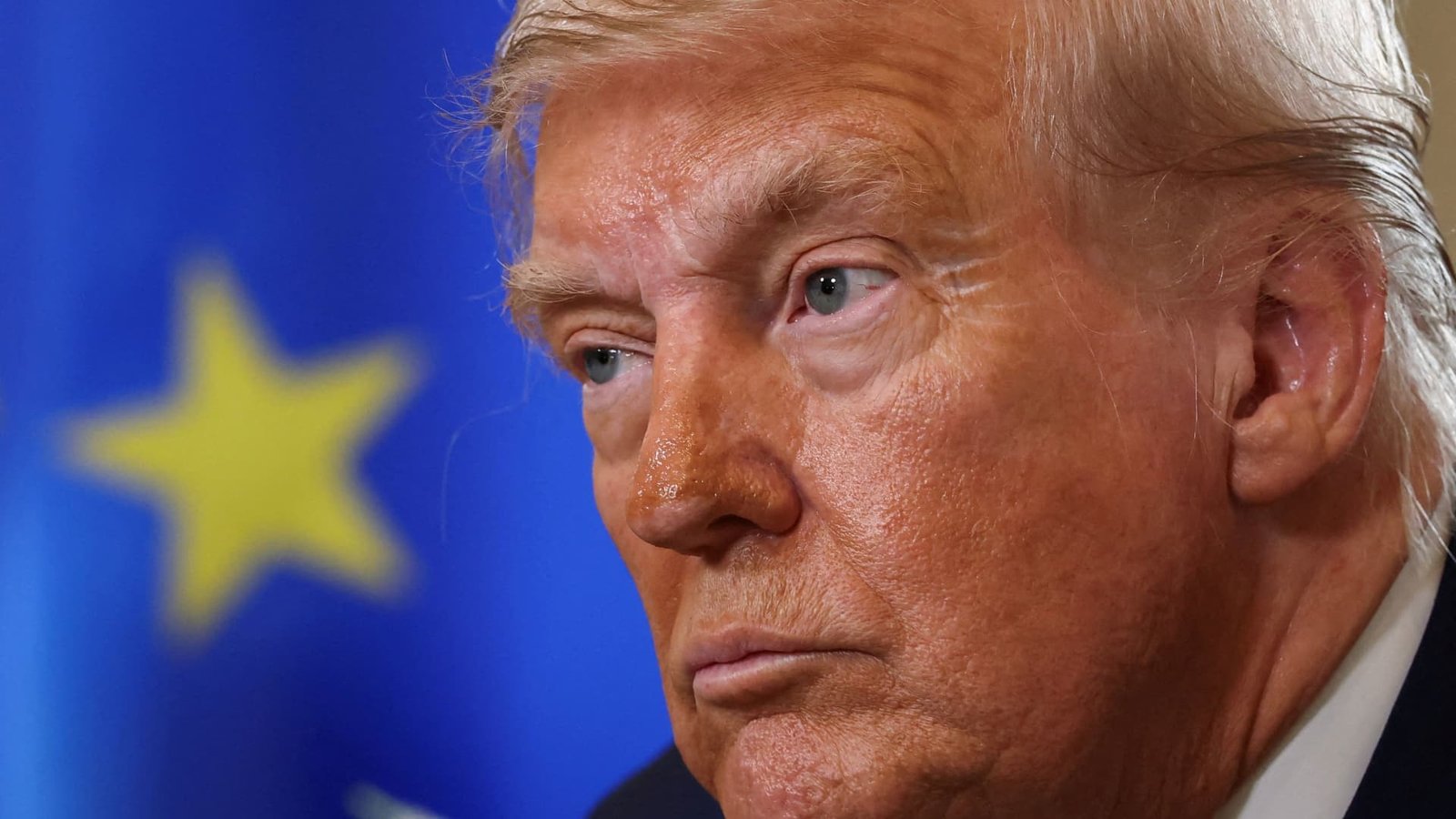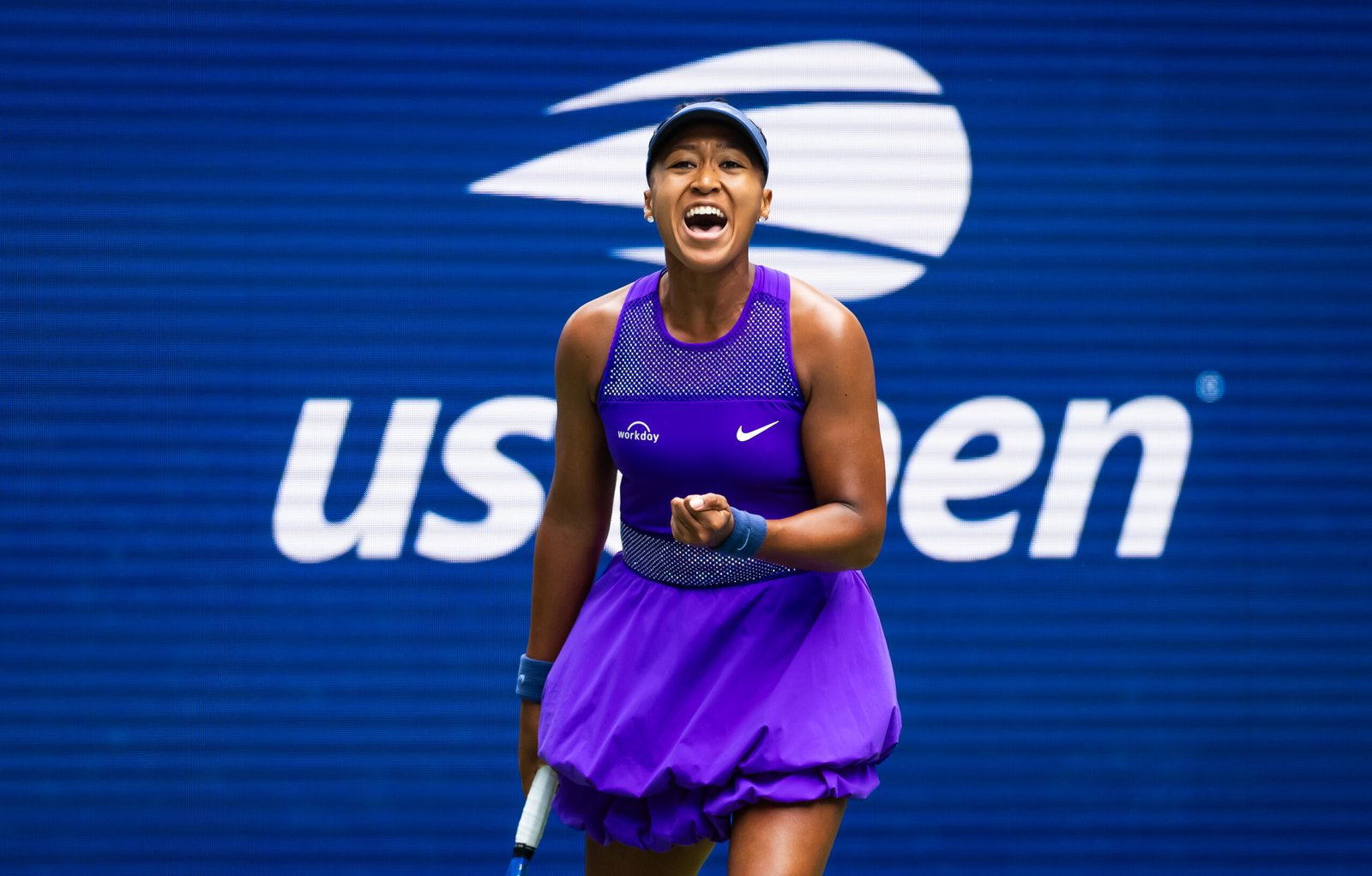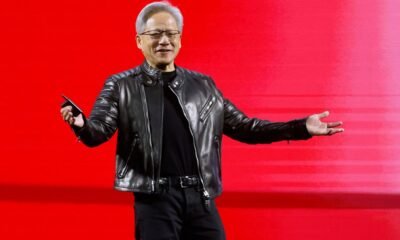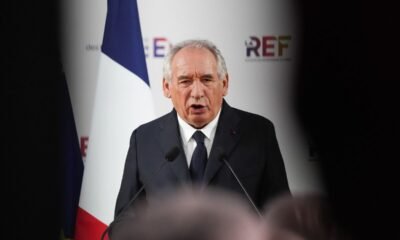Top Stories
Trump’s EU trade deal based on huge energy purchases that are unrealistic, analysts say

U.S. President Donald Trump looks on, during a meeting with European Commission President Ursula von der Leyen (not pictured), after an announcement of a trade deal between the U.S. and EU, in Turnberry, Scotland, Britain, July 27, 2025.
Evelyn Hockstein | Reuters
President Donald Trump’s massive energy deal with the European Union will be difficult to implement, setting Washington and Brussels up for a potential future confrontation over tariffs and trade.
The EU has agreed to purchase $750 billion of U.S. energy and invest $600 billion in the U.S. by 2028, according to the White House. In exchange, Trump has agreed to a tariff of 15% on EU goods excluding steel and aluminum, which is half the 30% rate that he had threatened.
But the $600 billion investment in the U.S. is not binding on EU member states or companies. The European Commission, the bloc’s executive body, simply said that companies “have expressed interest in investing at least” that amount in the U.S by 2029.
The massive energy purchases in the deal are unrealistic due to market and political constraints, analysts said. The EU cannot force member states and companies to buy U.S. energy just as the Trump administration cannot force producers to sell to Europe, said Mathieu Utting, an analyst at Rystad Energy.
“This is non-binding. It’s a pledge,” said Erik Brattberg, an expert on Europe at the Atlantic Council, a think-tank with a focus on international affairs. “The EU itself doesn’t buy energy. It would be member states or companies from member states.”
A White House official told CNBC on Tuesday that Trump expects the EU to abide by its commitments under the deal.
“That is what the EU agreed to purchase,” the official said. “The President reserves the right to adjust tariff rates if any party reneges.”
The energy purchases are divided into $250 billion annual installments over the rest of Trump’s term, European Commission President Ursula von der Leyen told reporters Sunday. The EU is pledging significant purchases U.S. oil, liquified natural gas (LNG) and nuclear fuel to replace Russian fossil fuels, von der Leyen said.
But it is unclear how much EU member states and companies intend to buy of each fuel type. “Details have to be sorted out and that will happen over the next weeks,” von der Leyen told reporters.
Tripling U.S. exports unrealistic
EU member states bought about $80 billion U.S. oil, liquified natural gas, liquified petroleum gas and coal from the U.S. in 2024, according to data from Kpler. The bloc would have to triple its purchases of U.S. energy to meet the $250 billion annual purchase target laid out in the agreement.
“If this deal were to be realized, we’d be talking about the United States providing the lion’s share of European energy imports,” Helima Croft, head of global commodity strategy at RBC Capital Markets, told CNBC on Monday. EU energy imports totaled $433 billion in 2024, according to Eurostat.
Increasing U.S. oil exports to the EU is difficult because production is flat and will likely decline in the coming months, said Svetlana Tretyakova, an oil analyst at Rystad.
U.S. companies would have to reroute exports from customers in Asia and Latin America to the EU, Tretyakova said. Importing more oil also does not align with the EU’s climate goals and the continent’s refining capacity is declining, she said.
Surging LNG exports is also tough, Utting said. U.S. terminals always run at full capacity so there isn’t slack capacity to increase shipments to the EU right now, he said. As in the case with oil, LNG would have to be diverted from other customers to Europe, he said.
More LNG capacity is coming online over the next two years that could be exported to Europe, he said. But the EU already receives more than half its imports from the U.S., Utting said.
“It’s very unrealistic that Europe would import exclusively from the U.S.,” he said. “They will want to diversify to some extent.”
While the headline $750 billion figure is unrealistic, the EU is showing that it is serious about expanding its energy trade with the U.S., said Alex Munton, director of global gas and LNG research at Rapidan Energy.
The EU was already planning to eliminate what remains of Russian LNG and pipeline gas imports to the bloc by 2028. This will create a supply gap of 25 million metric tons per year that the U.S. is perfectly positioned to fill, Munton said.
“The interests line up, they go hand in hand,” he said. “That’s why it’s essentially a convenient deal.”
Top Stories
Osaka’s reset comes full circle with win over Gauff at the US Open

NEW YORK — This was a fourth-round match with unusually large consequences, a highly charged litmus test, a gut-check in real time.
After missing the entire 2023 season on maternity leave, four-time Grand Slam champion Naomi Osaka has expressed frustration with her lack of progress. When would her game regain that ethereal major-winning quality?
Coco Gauff, even in the wake of a title at Roland Garros, turned to biomechanics specialist Gavin MacMillan just before the US Open, willing to sacrifice short-term results by playing the long game. Could she rely on her great strengths of speed and competitive fire while making significant adjustments to her serve and forehand?
The answers arrived in only 64 minutes on Monday in Arthur Ashe Stadium as Osaka dropped a decisive 6-3, 6-1 decision on Gauff to advance to the quarterfinals. It’s Osaka’s first major quarterfinal since winning the 2021 Australian Open.
It was reminiscent of the memorable match between the two here six years ago. Osaka, at the height of her powers, dispatched a 15-year-old Gauff 6-3, 6-0 in a third-round match that ended with tears. The difference is that Gauff was seeded No. 3 here and Osaka was No. 23.
“I mean I’m a little sensitive — I don’t want to cry,” Osaka said afterward. “Honestly I had so much fun out here.
“This is my favorite court in the world, and it means so much to be back here.”
Much has been made of Osaka’s move to coach Tomasz Wiktorowski. And while Iga Swiatek’s former coach has been a boon to her confidence, the difference between the 2024 Osaka and this year’s edition might just be fitness — and the confidence that brings.
Even earlier this year, she appeared sluggish at times, impatient to end points quickly. Against Gauff, Osaka moved exceptionally well, weathered long rallies and stayed in a visibly positive frame of mind. Her intensity was palpable.
So was her patience. Osaka won 16 of the 24 rallies that went five shots or more. She also converted each of the four break points she earned. Osaka next plays Karolina Muchova, a three-set winner against Marta Kostyuk.
Gauff, meanwhile, consistently struggled with her forehand and service game. There were five double faults, but the forehand was the real issue. Gauff had 20 unforced errors on that side. On this occasion, even her usually reliable backhand sometimes broke down.
Even early on, Gauff’s forehand was fluky (five errors) and Osaka broke and then held at love for a 2-0 lead.
But while Gauff — with a tweaked toss — had eased into her service games in the opening rounds, she came out firing against Osaka. She stroked two aces in her second service game and the other two first serves were unreturned. They were all 110 mph-plus.
That break was the only margin until Gauff, trailing 5-3, was broken again. Two double faults, in addition to two groundstroke errors, gave Osaka the set in 31 minutes.
With the match on serve at 3-2 in the second set, Gauff served into trouble. A double fault started it and an errant backhand closed it as Osaka converted her third break point in her third try.
Osaka scored one last break to secure the match.
Osaka is realistically trying to win her third US Open title in eight years. This is her fifth trip to the quarterfinals of a Grand Slam. It’s worth noting that she won the first four.
The turning point, Osaka said, came last month in Montreal.
That was when Osaka came back from down a set and 5-3, saving two match points, to defeat No. 13 seed Liudmila Samsonova in a match that went more than two-and a-half hours.
“Since then, I’ve been thinking anything’s possible,” Osaka said in her on-court interview. “You just have to have a smile on your face.”
Top Stories
The Rock Sobs as ‘The Smashing Machine’ Gets 15-Minute Venice Ovation

Is Dwayne Johnson headed for the Oscars?
Judging by the rapturous reaction to his performance as wrestler Mark Kerr in “The Smashing Machine” at the Venice Film Festival on Monday night, that seems to be the consensus out of Italy.
The 53-year-old actor sobbed uncontrollably as the audience on the Lido erupted into 15-minute standing ovation, one of the longest at this year’s festival so far.
Johnson, who once performed as the WWE wrestler known as the Rock, has been the star of such commercial fare as “The Mummy,” “Black Adam” and “Baywatch.” But he goes much deeper in his next project, which will be released by A24 in November, as a ’90s fighter with demons.
Johnson stars opposite Emily Blunt in the film, who plays Kerr’s girlfriend Dawn Staples. During the ovation, Benny Safdie — the film’s director — hugged both his stars and joined Johnson in shedding tears of joy as the clapping continued. Adding to the waterworks, Kerr also wept as the credits rolled.
As the hooting and cheering stretched on, “The Smashing Machine” proved to be the most emotional premiere on the Lido since Brendan Fraser collapsed into tears four years ago, launching his Oscar campaign for “The Whale.”
Before the screening started, one fan shouted Johnson’s signature WWE line, “Can you smell what the Rock is cooking?!” — prompting laughter from the man of the hour.
Johnson was in good spirits throughout the night. He worked one of Europe’s most glamorous red carpets, signing autographs for fans and snapping selfies. This year’s 82nd edition of Venice has been packed with stars — ranging from George Clooney to Julia Roberts to Emma Stone — and Johnson and Blunt added to the A-list wattage of the festival that’s now known as the official launch of awards season.
Johnson is nearly unrecognizable “The Smashing Machine,” undergoing pounds of prosthetics to portray the beefy two-time UFC Heavyweight champ. The actor previously told Variety that he was drawn to “The Smashing Machine” because Safdie is someone who “continues to push the envelope when it comes to stories that are raw and real; characters that are authentic and at times uncomfortable and arresting.”
“I’m at a point in my career where I want to push myself in ways that I’ve not pushed myself in the past,” said Johnson, best known for franchise fare like “Jumanji” and the “Fast and Furious” movies. “I want to make films that matter, that explore a humanity and explore struggle [and] pain.”
“The Smashing Machine” marks the solo feature directorial debut of Benny Safdie, who worked with his older brother, Josh, on indie favorites like “Good Time” and “Uncut Gems.” (Josh will also make his solo feature debut this year with A24’s “Marty Supreme,” a sports drama starring Timothee Chalamet.) “The Smashing Machine” reunites Benny Safdie and Blunt, who shared a memorable scene in Christopher Nolan’s historical epic “Oppenheimer,” as well as Johnson and Blunt, who co-starred in Disney’s action-adventure “Jungle Cruise.”
Top Stories
Naomi Osaka beats Coco Gauff to reach US Open quarterfinals

NEW YORK — Naomi Osaka eliminated Coco Gauff 6-3, 6-2 in 64 minutes at the US Open on Monday with a far more confident and consistent brand of tennis to reach her first Grand Slam quarterfinal in more than 4½ years.
Osaka advances to her fifth major quarterfinal, and first since giving birth to daughter Shai in July 2023. Every time Osaka has made the quarterfinal round of a major, she has gone on to win it, her last Slam coming at the 2021 Australian Open.
The No. 23-seeded Osaka was better throughout than No. 3 Gauff, whose repeated mistakes really made the difference in Arthur Ashe Stadium. Osaka never faced a break point and lost just six points on her serve.
“I was super locked in, to be honest. I was really locked in,” said Osaka, a 27-year-old who was born in Japan and moved to the U.S. with her family at age 3. “I felt like everyone wanted to watch a really great match, and I hope that’s what you got.”
Osaka displayed the demeanor, big serve and booming strokes that have carried her to four major championships, all on hard courts. That includes titles at the US Open in 2018 and 2020, and at the Australian Open in 2019 and 2021.
It was at the French Open later in 2021 that Osaka helped spark a global conversation about mental health by revealing she felt anxiety and depression. She then took a series of breaks from the tour.
That most recent trophy at Melbourne Park was the last time Osaka had even made it as far as the fourth round at any Slam event until this match against Gauff, a 21-year-old from Florida who owns two major trophies. The first came at Flushing Meadows in 2023 and the second at the French Open this June.
For Osaka, this marks a real return to her best play since she returned to the tour after a 17-month maternity leave.
“I’m a little sensitive and I don’t want to cry, but honestly, I just had so much fun out here,” said Osaka, who first played Gauff back at the 2019 US Open, also in Ashe, and won that one, too.
“I was in the stands like two months after I gave birth to my daughter, watching Coco. I just really wanted an opportunity to come out here and play,” Osaka told the crowd. “This is my favorite court in the world, and it means so much for me to be back here.”
Gauff came out jittery at the start. Her serve was fine; other strokes were the problem. She finished with 33 unforced errors — way more than Osaka’s 12.
Trying to rework her serve during this tournament with the help of biomechanics expert Gavin MacMillan, Gauff got broken right off the bat and was down 2-0 after just five minutes, dropping eight of the initial nine points while making five unforced errors.
Whether because it’s what the prematch strategy dictated or because of how the beginning unfolded, Gauff cranked up the velocity in her second service game. The results were unimpeachable. She hit four first serves in — each arriving no slower than 110 mph, with a high of 115 mph — and held at love with a pair of aces and a pair of service winners.
Still, this is where the key difference was: Osaka used her big forehand, her best stroke, to go after Gauff’s forehand, her worst stroke, and it worked wonders. By the end of the first set, Gauff had made 16 unforced errors and Osaka only five.
ESPN Research and The Associated Press contributed to this report.
-

 Business3 days ago
Business3 days agoThe Guardian view on Trump and the Fed: independence is no substitute for accountability | Editorial
-
Tools & Platforms3 weeks ago
Building Trust in Military AI Starts with Opening the Black Box – War on the Rocks
-

 Ethics & Policy1 month ago
Ethics & Policy1 month agoSDAIA Supports Saudi Arabia’s Leadership in Shaping Global AI Ethics, Policy, and Research – وكالة الأنباء السعودية
-

 Events & Conferences3 months ago
Events & Conferences3 months agoJourney to 1000 models: Scaling Instagram’s recommendation system
-

 Jobs & Careers2 months ago
Jobs & Careers2 months agoMumbai-based Perplexity Alternative Has 60k+ Users Without Funding
-

 Funding & Business2 months ago
Funding & Business2 months agoKayak and Expedia race to build AI travel agents that turn social posts into itineraries
-

 Education2 months ago
Education2 months agoVEX Robotics launches AI-powered classroom robotics system
-

 Podcasts & Talks2 months ago
Podcasts & Talks2 months agoHappy 4th of July! 🎆 Made with Veo 3 in Gemini
-

 Podcasts & Talks2 months ago
Podcasts & Talks2 months agoOpenAI 🤝 @teamganassi
-

 Mergers & Acquisitions2 months ago
Mergers & Acquisitions2 months agoDonald Trump suggests US government review subsidies to Elon Musk’s companies





















